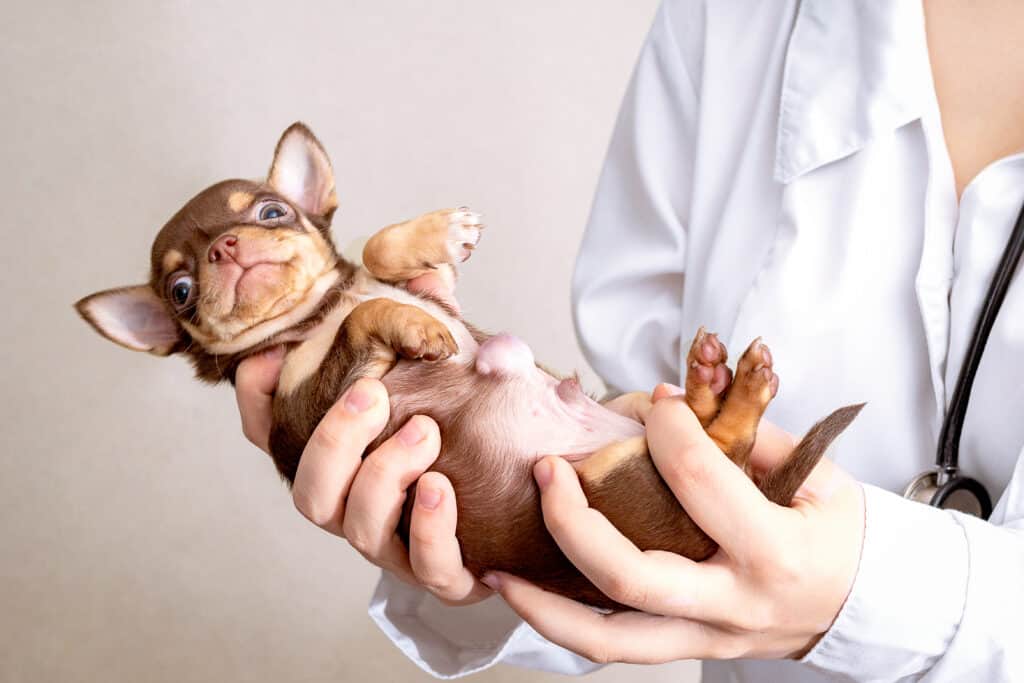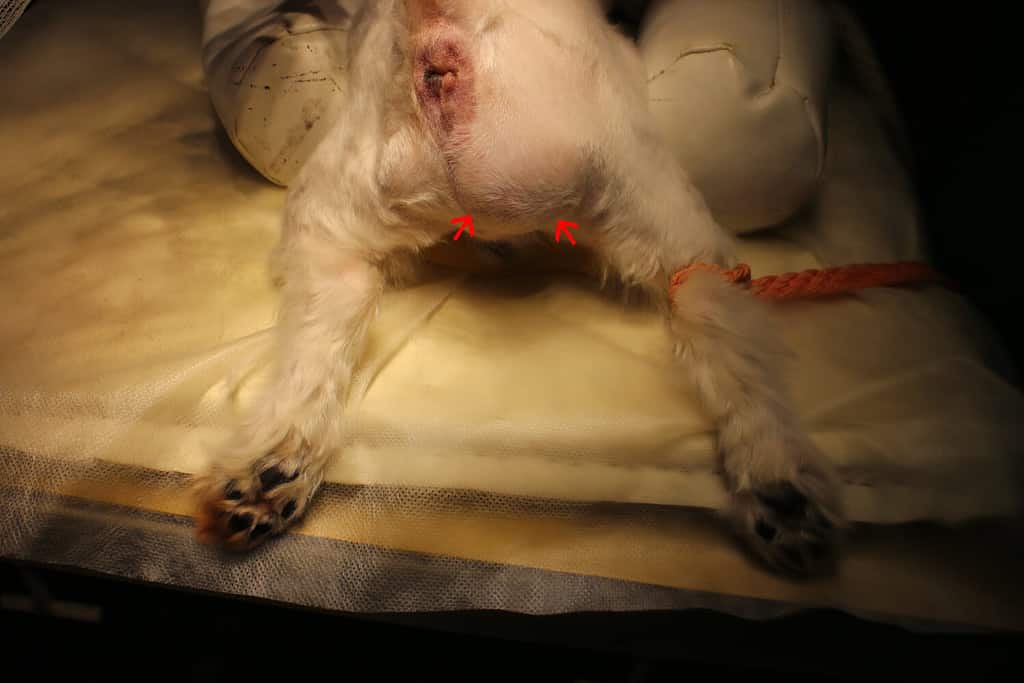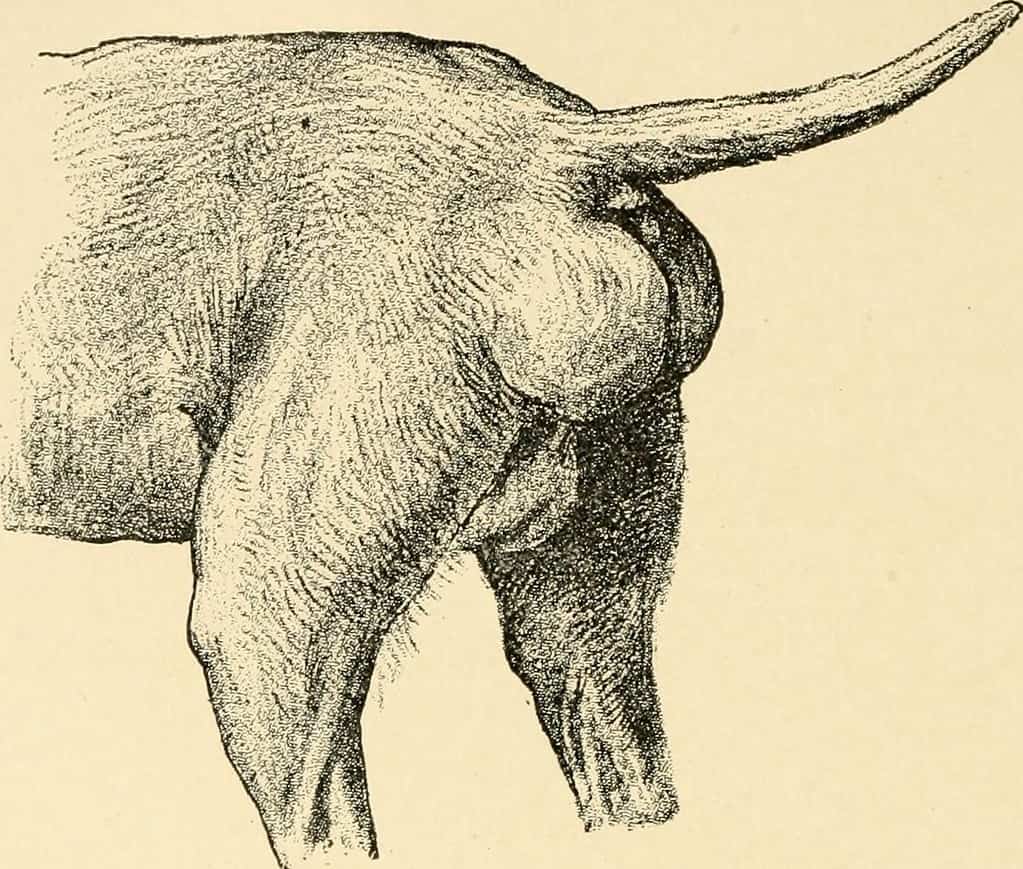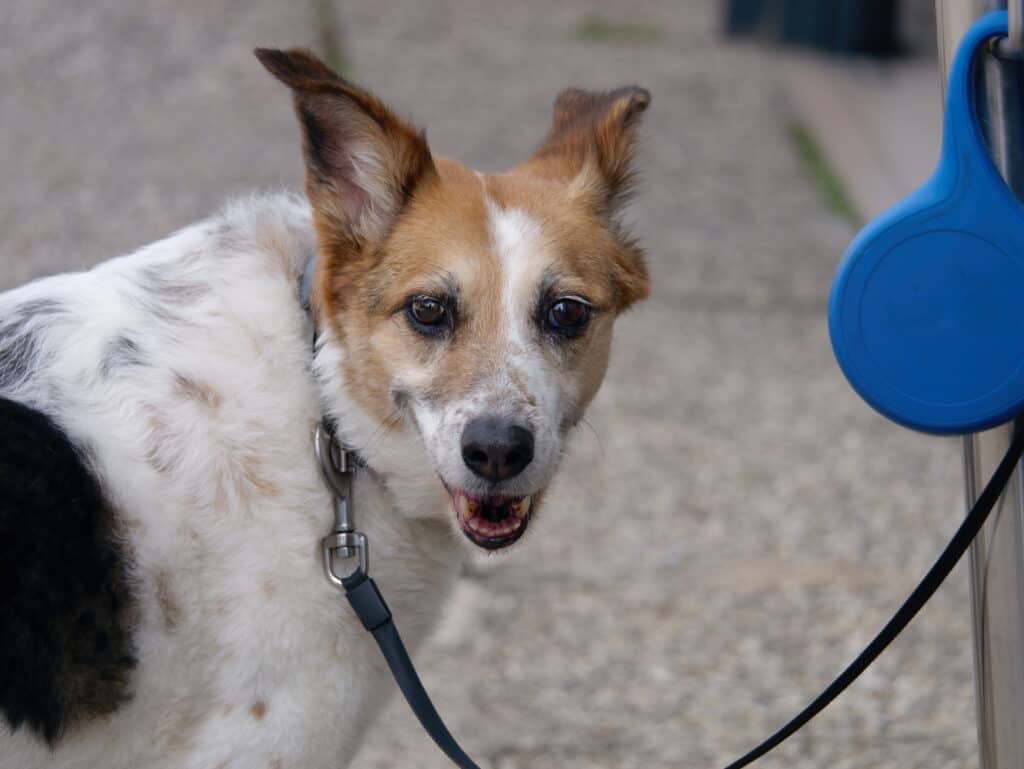Hernias in dogs form before birth in 90% of cases. In the other 10%, they’re caused by injuries or trauma. Intact dogs, or those who aren’t spayed or neutered, are at an increased risk of developing certain types of hernias as well.
In this article, we’ll talk about the five types of hernias in dogs, their causes, and how they’re diagnosed and treated.

Hernias in dogs form before birth in 90% of cases.
©Lara Ezhkova/Shutterstock.com
5 Types of Hernias in Dogs
Umbilical Hernia
Umbilical hernias are the most common hernias in puppies. They occur near the belly button and have varying degrees of severity.
Sometimes, small hernias will go away on their own or can be fixed during neutering. Hernias that are larger risk the organs falling through, which puts the puppy at greater risk and may require more immediate surgery.

Hernias that are larger risk the organs falling through.
©Tatiana Cutrone/Shutterstock.com
Inguinal Hernia
Inguinal hernias occur where a dog’s hind leg attaches to their body, on the underside by their tummy.
They mostly affect pregnant female dogs, though other dogs can still develop them. These hernias are at risk of trapping the bladder, womb, and bowl, which is life-threatening.
When surgery is required, it’s often done on both sides as they’re usually both affected.

These hernias are at risk of trapping the bladder, womb, and bowl, which is life-threatening.
©P.Fabian/Shutterstock.com
Diaphragmatic Hernia

A dog’s prognosis is good if they can survive the first 48 hours after surgery, but overall this is a critical diagnosis.
©Trevor Reeves/Shutterstock.com
Diaphragmatic hernias are in a dog’s diaphragm, which is a muscle located between the chest and abdomen. Dogs can be born with a diaphragmatic hernia, or it can develop due to trauma.
The biggest risk of these hernias is that the abdominal organs can enter the chest, making it difficult for a dog to breathe.
Because of this, it’s an emergent condition that typically requires surgery. If your dog has other injuries from a trauma, they may be hospitalized while the vet waits for them to stabilize enough for surgery.
A dog’s prognosis is good if they can survive the first 48 hours after surgery, but overall this is a critical diagnosis.
Perineal Hernia

Genitals can become trapped by this type of hernia if it becomes large enough.
©https://www.flickr.com/photos/internetarchivebookimages/14598312959/ – License
Perineal hernias are tears in a dog’s pelvic muscles. They’re most common in intact males over five years of age.
Collies, Boston Terriers, and some other breeds are more likely to develop perineal hernias due to their genetics.
Genitals can become trapped by this type of hernia if it becomes large enough. Treatment often requires surgery and may include stool softeners to prevent a dog from straining when they poop, as this can increase the size of the hernia.
Less severe hernias may heal with medication, including acid-blockers and medications to empty the stomach.
Neutering your dog during or after treatment reduces the chance that they’ll develop more hernias in the future and will likely be recommended by your vet.
Hiatal Hernia
Hiatal hernias are large openings in the diaphragm.This allows the stomach to move back and forth from the chest to the abdomen.
While they’re typically caused by injury or trauma, some dogs are born with hiatal hernias as well. They’re most common in brachycephalic, or short-snouted, breeds.
Symptoms of Hernias in Dogs

Look for symptoms such as vomiting, swelling, excessive drooling and trouble breathing.
©didesign021/Shutterstock.com
- A soft, protruding mass
- Swelling in the area the hernia is located
- Vomiting
- Decreased appetite
- Excessive drooling
- Difficulty breathing
Diagnosing Dog Hernias
Diagnosis of hernias takes multiple steps. First, a vet will perform a basic examination of your dog, which will include feeling their body for any masses or swelling.
They’ll also ask questions about your dog’s health and any symptoms you’ve noticed at home.
To confirm diagnosis of a hernia, they’ll then perform x-rays or an ultrasound.
Your veterinarian may also perform other tests, such as bloodwork, to either rule out other illnesses or confirm that a hernia is present.
Treatment of Hernias in Dogs

Vets must perform surgery to repair the hernia.
©Topolszczak/Shutterstock.com
Treatment may be as simple as waiting for the hernia to clear on its own if it’s small, especially in the case of umbilical hernias.
Sometimes a vet may need to prescribe medication to help a dog’s symptoms as the hernia heals, or to ensure the hernia doesn’t become larger. For instance, stool softeners may be given to a dog with a perineal hernia to prevent them from straining and tearing it further.
In many cases, vets must perform surgery to repair the hernia and possibly to move the organs back into place if they’ve fallen through to the wrong location.
Preventing Hernias in Dogs

Dogs should only be allowed off-leash if they can recall (come when called) in any and all circumstances.
©iStock.com/Ivica Gulija
Most hernias cannot be prevented because dogs are born with them as puppies. However, there are ways to prevent older dogs from developing hernias.
First, spay or neuter your dog once they’re fully grown (or whenever your vet recommends based on their breed). This will prevent pregnancies, which can cause inguinal hernias. Neutering can also lessen your dog’s chance of developing perineal hernias, since these are most common in unneutered males.
Next, you want to ensure your dog doesn’t suffer from severe injuries or trauma, which can cause hernias.
Dogs should only be allowed off-leash if they can recall (come when called) in any and all circumstances. Otherwise, they should always be on-leash or in an enclosed space.
If your dog is an escape artist, make sure your yard is properly enclosed. This might mean a tall fence they cannot jump over, or fencing that continues underground to prevent digging. Alternately, you can supervise them in the yard so that they can’t escape without you seeing.
Lastly, for door dashers–close your dog in another room using a door, gate, or crate before opening the door. This is a short-term solution, while a longer-term one would be to train them not to cross the doorway without you giving the okay.
Most dogs suffer injuries when they run away and don’t have anyone supervising them, or when they’re allowed off-leash around car traffic or unknown dogs.
Luckily, controlling hernias caused by injuries is almost one-hundred percent within our control. As pet owners, it’s our responsibility to keep our dogs safe. Even though they can be a little stubborn about following the rules.
The photo featured at the top of this post is © P.Fabian/Shutterstock.com
Ready to discover the top 10 cutest dog breeds in the entire world?
How about the fastest dogs, the largest dogs and those that are -- quite frankly -- just the kindest dogs on the planet? Each day, AZ Animals sends out lists just like this to our thousands of email subscribers. And the best part? It's FREE. Join today by entering your email below.
Thank you for reading! Have some feedback for us? Contact the AZ Animals editorial team.






